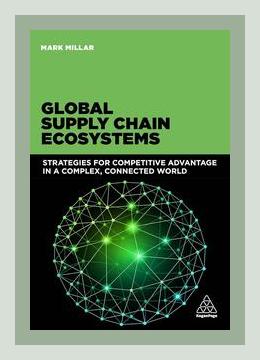Operations and Supply Chain ManagementSupply Chain OptimizationLogistics
Introduction
Mark Millar’s 2015 book, Global Supply Chain Ecosystems: Strategies for Competitive Advantage in a Complex, Connected World, delves into the burgeoning complexities of supply chain management in the modern, interconnected world. It traverses through the interconnected aspects of supply chains, logistics, and the imperative strategies needed to stay competitive. With in-depth analyses and real-world examples, Millar orchestrates a clear pathway for businesses to optimize their supply chain operations.
1. Understanding Supply Chain Ecosystems
Major Point:
Millar begins by framing supply chain management within an ecosystem perspective, illustrating how interconnected and interdependent these systems are.
Actionable Insight:
– Action: Perform a detailed mapping of your supply chain network, identifying key nodes and understanding their interdependencies.
Example:
– Millar provides the example of Apple, which has created a symbiotic relationship between its suppliers and assembly lines, fostering an environment that streamlines its product pipeline.
2. Embracing Complexity and Change
Major Point:
The book emphasizes embracing rather than resisting the complexity inherent in global supply chains. Companies must be agile and adaptable to rapidly changing environments.
Actionable Insight:
– Action: Establish a dynamic risk management framework to quickly respond to disruptions.
Example:
– Millar cites Toyota’s response to the 2011 earthquake in Japan, detailing how their pre-established risk management strategies allowed them to mitigate disruptions.
3. Leveraging Technology and Innovation
Major Point:
Technological advancements are a cornerstone of modern supply chains. From AI to IoT, embracing these tools can provide significant competitive advantages.
Actionable Insight:
– Action: Invest in digitalization initiatives and integrate IoT devices to gain real-time visibility into supply chain processes.
Example:
– The use of IoT sensors by Maersk to monitor the conditions of perishable goods during transit illustrates the powerful impact of technological innovation.
4. Enhancing Collaboration and Relationships
Major Point:
Collaboration across the supply chain, involving suppliers, partners, and even competitors, can lead to optimized performance and innovative solutions.
Actionable Insight:
– Action: Develop strategic alliances with key partners to foster trust and collaboration for mutual benefits.
Example:
– P&G and Walmart’s collaboration on sharing inventory data exemplifies how strategic partnerships can drive efficiency.
5. Navigating Globalization
Major Point:
Globalization creates both opportunities and challenges. Companies must navigate tariffs, customs, and geopolitical risks effectively.
Actionable Insight:
– Action: Diversify your supplier base to hedge against geopolitical risks and tariffs.
Example:
– Millar discusses Nike’s strategy of diversifying its manufacturing locations across Asia to mitigate risks related to tariffs and regional disruptions.
6. Focus on Sustainability
Major Point:
Sustainability is becoming a critical factor for competitive advantage. Companies should focus on eco-friendly practices and reduce their carbon footprint.
Actionable Insight:
– Action: Implement green logistics and sustainability initiatives in your supply chain operations.
Example:
– The example of Unilever, which has committed to achieving a zero-carbon supply chain by 2039, underlines how sustainability can be ingrained into the business strategy.
7. The Role of Human Resources in Supply Chains
Major Point:
People are the backbone of supply chains. Effective talent management and workforce skills development are essential.
Actionable Insight:
– Action: Invest in training programs to upskill your workforce and cultivate expertise in supply chain management.
Example:
– DHL’s investment in its Supply Chain Academy highlights the importance of continuous learning and development in enhancing operational efficiency.
8. Adopting Lean and Agile Practices
Major Point:
Lean practices help in waste reduction, while agility allows firms to respond swiftly to market demands.
Actionable Insight:
– Action: Integrate lean methods to streamline operations and cultivate agile practices to quickly adapt to changes.
Example:
– Zara employs a highly responsive and agile supply chain, allowing it to bring new designs from the runway to stores in mere weeks.
9. Enhancing Customer-Centricity
Major Point:
Focus on customer needs and preferences can significantly enhance competitive advantage.
Actionable Insight:
– Action: Utilize customer feedback loops to fine-tune supply chain operations and align them with market demands.
Example:
– Millar points out Amazon’s relentless focus on customer satisfaction and its sophisticated logistics network designed to meet and exceed customer expectations.
10. Innovation and Continuous Improvement
Major Point:
Innovation is not a one-time event but a continuous process. Encouraging a culture of constant improvement and innovation is crucial.
Actionable Insight:
– Action: Foster an innovation culture within your organization, encouraging employees to contribute ideas for improving supply chain processes.
Example:
– 3M’s “15% rule,” where employees are encouraged to spend 15% of their time on projects of their choosing, exemplifies how fostering a culture of innovation can lead to breakthrough ideas.
Conclusion
Millar’s Global Supply Chain Ecosystems offers a comprehensive guide for navigating the complexities of modern supply chains. From leveraging technology and fostering collaboration to enhancing sustainability and customer-centricity, each chapter is packed with actionable insights and real-world examples. By applying these strategies, businesses can not only optimize their supply chain operations but also achieve sustained competitive advantage in an increasingly interconnected and complex world.
Operations and Supply Chain ManagementSupply Chain OptimizationLogistics
